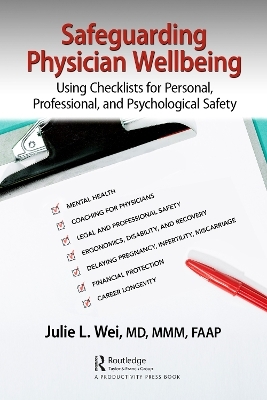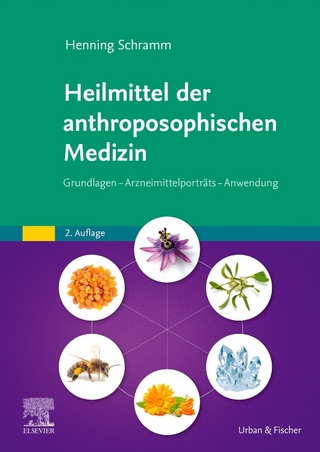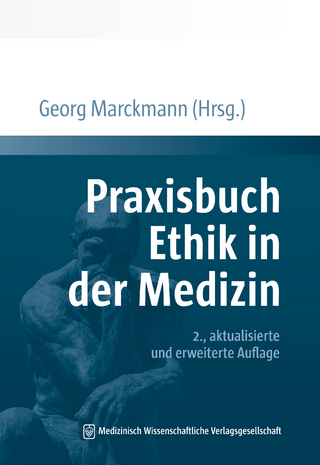
Safeguarding Physician Wellbeing
Productivity Press (Verlag)
978-1-032-58990-9 (ISBN)
The United States is facing a worsening epidemic of physician burnout with unprecedented numbers of them leaving the workforce and practice of clinical medicine across all career stages. The prevalence of physician burnout has accelerated through COVID-19, resulting in an anticipated serious national shortage of physicians within the current decade amidst an increased proportion of aging and unhealthy population.
The critical shortage of physicians coupled with an unhealthy physician workforce results in longer wait times for access, continued increased healthcare costs, decreased quality of care, and worsening patient experience.
Despite increasing media coverage, published data, and identification of system-based factors that erode physician wellbeing, no standardized systematic solution has been implemented across hospitals, health systems, or a variety of employment models or practice settings for any or all doctors regardless of whether they are primary care, medical, or surgical subspecialists.
Effective solutions to mitigate physician burnout, protect current working physicians, and keep them from leaving medicine require a SHIFT and a more individualized approach. Many proposed academic models address system-based factors, but such solutions depend greatly on those who employ doctors. Executive leadership in charge of healthcare systems are often challenged by physician burnout and their desired autonomy, against the need for standardization of care delivery to improve quality and decrease cost. Physician productivity measures continue to be based on data samples of physician compensation surveys supplied by companies like Sullivan Cotter or Medical Group Management Association (MGMA). Such benchmarks are commonly used but data may not reflect specific realities for any organizations nor the rapid changes in the landscape of US healthcare amidst mergers, acquisitions, consolidation, and shifts in employment models from insurance and online retail giants and private equity.
This book uses a "checklist" approach to empower any medical student, resident, fellow, or practicing physician to create and experience psychological, personal, and professional safety and wellbeing. Not only can individual physicians choose and use these checklists themselves, but those who live with, love, and cherish one or more physicians in their families and/or lives can use this book to understand physician realities and their risks.
Julie L. Wei, MD MMM, is a Pediatric Otolaryngologist and new Division Director, the Dr. Alfred J. Magoline Chair of Otolaryngology, at Akron Children’s Hospital in Akron Ohio. She is also a Professor of Otolaryngology Head Neck Surgery at University of Cincinnati College of Medicine and faculty in the ENT Division at Cincinnati Children’s Hospital Medical Center. Dr. Wei obtained her medical degree from New York Medical College, ENT residency training at Mayo Clinic Rochester, fellowship training at the now Lurie Children’s Hospital in Chicago. She completed her master’s in medical management from Carnegie Mellon University’s Heinz College of Information Systems and Public Policy in May 2023. In addition to serving as division chief, Dr. Wei has also served as Surgeon-in-Chief, Director, GME Wellbeing Initiative, Chair of Medical Staff Health & Wellness Committee at Nemours Children’s Hospital Orlando, and as Chair of Otolaryngology Education and Advisor for Association of Women Surgeons at University of Central Florida College of Medicine for the past near decade. She is the immediate past president of American Society of Pediatric Otolaryngology and past president of Society of Ear, Nose, Throat Advances for Children. She is author of “A Healthier Wei”, and co-author of “Acid Reflux in Children”, and TEDx speaker on “The Milk and Cookie Disease”. She has published over 48 peer-reviewed articles, 13 invited articles, 12 book chapters.
Chapter One: My Journey Chapter Two: Physician Safety Chapter Three: Data on Physician Burnout and WHY Chapter Four: Checklists for Professional Protection Chapter Five: Coaching for Physicians (by Physicians and Non-Physicians) Chapter Six: Checklists for Work-Life Integration and Personal Safety Chapter Seven: Checklists for Financial Wellbeing and Safety Chapter Eight: Mental Health Checklists Chapter Nine: Checklists for Better Relationships Chapter Ten: Checklists for Career Longevity Chapter Eleven: Checklists for Ergonomics, Disability, and Recovery Chapter Twelve: Delaying Pregnancy, Miscarriages, and Infertility Chapter Thirteen: How to “Off-Ramp”, “On-Ramp”, or Exit Your Clinical Career Safely Chapter Fourteen: What Hospitals, Health Systems, Institutions Can Do to Ensure Healthy Physician Workforce. Chapter Fifteen: Checklists for Optimal Future of U.S. Healthcare
| Erscheinungsdatum | 27.02.2024 |
|---|---|
| Zusatzinfo | 1 Line drawings, black and white; 1 Illustrations, black and white |
| Verlagsort | London |
| Sprache | englisch |
| Maße | 152 x 229 mm |
| Gewicht | 453 g |
| Themenwelt | Medizin / Pharmazie ► Medizinische Fachgebiete ► Medizinethik |
| Wirtschaft ► Betriebswirtschaft / Management ► Planung / Organisation | |
| Wirtschaft ► Volkswirtschaftslehre | |
| ISBN-10 | 1-032-58990-6 / 1032589906 |
| ISBN-13 | 978-1-032-58990-9 / 9781032589909 |
| Zustand | Neuware |
| Informationen gemäß Produktsicherheitsverordnung (GPSR) | |
| Haben Sie eine Frage zum Produkt? |
aus dem Bereich


